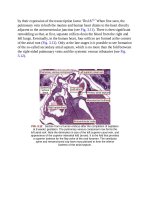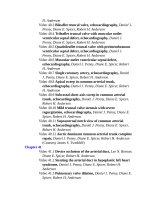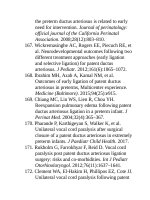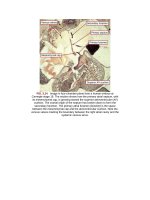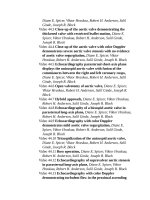Andersons pediatric cardiology 197
Bạn đang xem bản rút gọn của tài liệu. Xem và tải ngay bản đầy đủ của tài liệu tại đây (59.51 KB, 3 trang )
whichremainsvasoconstrictedinlambsbecauseofthelowoxygensaturationof
thebloodsuppliedtothepulmonaryarteries.Oftheleftventricularoutput,the
majoritypassesintotheheadandupperlimbs,returningtotherightatriumvia
thesuperiorvenacava(SVC),whileasmallproportionpassesacrosstheaortic
isthmustojointheductusarteriosusflowinthedescendingaorta.Rudolph
estimatedthatdescendingaorticflowaccountedforapproximately40%ofthe
combinedventricularoutputinthehumanfetus,with25%beingreturnedtothe
placentaviatheumbilicalveins.Foramenovaleflowwascalculatedtocomprise
20%ofthecombinedventricularoutput,with3%beingsuppliedtothecoronary
circulation.Similarestimatesofthedistributionofthenormalfetalcirculation
havesubsequentlybeenreportedbasedonultrasoundmeasurementsofblood
flowmadeinhumanfetuses.3–10However,themeasurementoffetalvesselflow
byultrasoundischallengingduetodifficultiesinaccountingforvariationsin
flowvelocityacrossthevessellumen,problemswithmakingaccuratevessel
areameasurements,andlimitationsinobtaininganadequateangleofinsonation.
Theselimitationshaveresultedinlimiteddataregardingtheredistributionof
flowthatisexpectedtoresultfromCHDinthefetus.Instead,investigatorshave
focusedonotherDopplerultrasoundmeasures,suchaspeakvelocityor
pulsatilityindex,toassesstheimpactofobstructionstofloworchangesin
downstreamvascularresistancetohelpinterpretfetalcardiovascularphysiology
inhumanfetuseswithCHD.Similarly,changesinfetaloxygenationhavebeen
inferredfromDopplerassessmentsofchangesinplacentalandcerebralvascular
resistance,andsosuchdataalsohavemajorlimitations.
MagneticResonanceImaging
TechniquesforAssessingFetal
CirculatoryPhysiology
Whiletechnicalchallengesarisingfromartifactsresultingfromfetalmotionand
difficultiesinobtainingadequatesignalfromsmallbloodvesselsremain,
noninvasiveMRItechniquesforuseinhumanpregnancieshaverecentlybeen
developed.Thedatafromthesestudiesresembletheinvasiveflowandoximetry
measurementsthatRudolphfirstreportedinfetalsheep50yearsago.This
approachiscurrentlyonlyfeasibleinlate-gestationfetusesandconsistsofcine
phasecontrastvesselflowmeasurementsandoximetrybasedonmagnetic
resonance(MR)relaxometry.
CinePhaseContrastMagnetic
ResonanceImagingFlowQuantification
Astheelectrocardiographicsignalusuallyusedfortemporalcalibrationof
cardiacMRIisnoteasilyavailablefromthefetus,alternativemethodsfor
achievinghigh-resolutionflowmeasurementshavebeendeveloped.Metric
optimizedgatingisatechniquethatusesapostprocessingsolutiontoachieve
cardiactriggering.11Tosummarize,theMRIdataareacquiredusinganartificial
QRScomplex,whichhasbeenprogrammedintotheimagingacquisition,as
showninFig.7.1.Thedataarethenreconstructedthrougharangeofcandidate
heartrates,withtheheartratethatwaspresentduringthatparticularacquisition
identifiedthroughthelackofartifactintheresultingimages.Examplesofcine
phasecontrastacquisitionsobtainedintheascendingaortaat1.5and3.0Tusing
metricoptimizedgatingareshowninFig.7.2,whichdemonstratesthe
improvementinsignal-to-noiseratiowithhighermagneticfieldstrength.The
imagingplaneisobtainedintheshortaxisofthevessel,allowingfor“through
plane”quantificationofflow.Theaccuracyoftheflowmeasurementdependson
achievingatrueshort-axisorientation,whichcanbeachievedbyobtainingtwo
orthogonallong-axisviewsusinganatomicsurveyimagesthroughthethorax
andupperabdomen.Followingmetricoptimizationofthephasecontrast
acquisition,aregionofinterestisplacedaroundthevesselusingstandard
postprocessingsoftwareinordertoquantifyflow,whichcanbeindexedtofetal
volume(orweight)basedonsegmentationofthefetalenvelope.Whenacquiring
phasecontrastflowimagingitisimportanttohaveadequatespatialresolution,
whichentailsprovidingatleast8voxelsacrossthevesselcross-section,and
adequatetemporalresolution—intherangeof50msorbetter.
